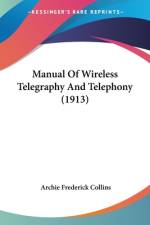von Archie Frederick Collins
41,00 €
The Manual Of Wireless Telegraphy And Telephony is a comprehensive guide to the principles and practices of wireless communication, written by Archie Frederick Collins and first published in 1913. The book covers a wide range of topics related to wireless technology, including the history of wireless communication, the physics of electromagnetic waves, the design and operation of wireless transmitters and receivers, and the practical applications of wireless telegraphy and telephony in the fields of maritime and military communication. The book is divided into several sections, each of which covers a different aspect of wireless communication. The first section provides an overview of the history of wireless technology, from the earliest experiments with electric telegraphy to the development of wireless telegraphy and telephony in the early 20th century. The second section focuses on the physics of electromagnetic waves, including their properties, behavior, and propagation through space. The third section of the book covers the design and operation of wireless transmitters and receivers, including the principles of antenna design, the use of tuning circuits and amplifiers, and the techniques of modulation and demodulation. The fourth section discusses the practical applications of wireless telegraphy and telephony in the fields of maritime and military communication, including the use of wireless technology for ship-to-ship and ship-to-shore communication, and for military signaling and reconnaissance. Throughout the book, Collins provides detailed explanations of the technical principles and practical applications of wireless communication, making it an invaluable resource for anyone interested in the history and development of wireless technology. Despite being over a century old, the Manual Of Wireless Telegraphy And Telephony remains a fascinating and informative guide to the principles and practices of wireless communication.This scarce antiquarian book is a facsimile reprint of the old original and may contain some imperfections such as library marks and notations. Because we believe this work is culturally important, we have made it available as part of our commitment for protecting, preserving, and promoting the world's literature in affordable, high quality, modern editions, that are true to their original work.






